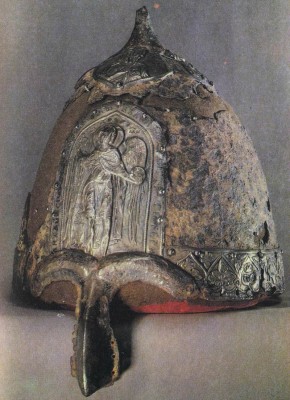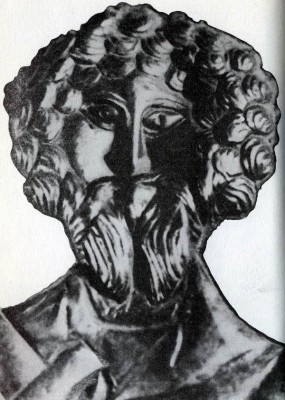The Chronicle-Writing of North-Eastern Russia
One of the earliest surviving manuscripts of a Russian chronicle is The Laurentian Chronicle, which got its name from a note at the end of the manuscript copied in 1377 in the principality of Nizhny Novgorod-Suzdal to the effect that the chronicle was copied by the monk Laurentius and his assistants. This manuscript is a copy of a chronicle compiled in 1305 (for more about the 1305 compilation see below). After analysing the text of The Laurentian Chronicle, specialists concluded that, among other things, it reflects the chronicle compilations of Ryazan and Rostov that were made not long after the invasion of Batu and have not survived in manuscript form.
The theory of the existence of Ryazan chronicle-writing was advanced by Vasily Komarovich, who believed that the Ryazan chronicle was compiled shortly after the defeat of Ryazan in 1237 by Batu’s forces. The existence of this compilation and its date are deduced from the fact that nearly all chronicle compilations known to date begin their account of Batu’s invasion of Russia with Ryazan. In particular, in the episode relating the fate of Ryazan one senses “the voice of a direct observer and even participant in the events described”.3 A characteristic feature of this compilation is the diatribe against the princes: because of the princes’ refusal to put the interests of the common cause before their private interests, the Russian hosts, in spite of their heroism, could not withstand the foe. This denunciatory tendency is seen most clearly in the tale of Batu’s sacking of Ryazan.
The chronicler exclaims bitterly that even before Batu’s invasion “the Lord had taken away our strength and planted folly, and terror, and fear, and trepidation in us for our sins”.4 The “folly”, the neglect of common interests for selfish motives, was the cause of the unconcerted actions of princes in the face of the terrible threat. The Ryazan chronicle account of Batu’s invasion also reflects some oral epic tales of the events. When the nomads invaded Ryazan soil they sent their emissaries to the princes of Ryazan, “a sorceress and two men”, to demand “a tithe of everything—people, princes and horses”. The oral tales of Batu’s invasion of Ryazan and the account of the event in the Ryazan chronicle subsequently formed the basis of The Tale of Batu’s Capture of Ryazan.5
Before Batu’s invasion the Grand Prince’s chronicle-writing was done in Vladimir. After the destruction of Vladimir it moved to Rostov. Dmitry Likhachev believes that an important role in Rostov chronicle-writing was played by Princess Maria, the wife of Prince Vasilko of Rostov killed during Batu’s invasion in 1238 and the daughter of Prince Michael of Chernigov, killed in the Horde in 1246.
In 1262 a series of uprisings against the Horde took place in the towns of the Rostov principality. The chronicle compiled after these events, which Dmitry Likhachev calls the Maria chronicle compilation, “is completely imbued with the idea of standing firm for the faith and independence of the homeland. It is this idea that determined both the content and the form of the chronicle. The Maria chronicle combines a number of tales about the tragic death of Russian princes who refused to compromise with their conquerors.”6 It includes the tale of the death of Maria’s husband Vasilko in 1238 in the battle on the River Sit, the account of the moving of Grand Prince Yuri’s body to Vladimir (he was killed in the fighting on the Sit, and his body taken from the battle field first to Rostov, then to Vladimir), and the entry under 1246 on the killing of Michael of Chernigov, Maria’s father, in the Horde.
The story about Grand Prince Yuri stresses not only his military valour (he rejects the enemy’s offer of peace), but also the fact that his death was a martyr’s one for the Christian faith.7
The idea of boundless devotion to duty and the faith is even stronger in the story about Vasilko and the entry on the death of Michael of Chernigov—they do not betray the Orthodox faith or agree to recognise the pagan faith of the conquerors. The readiness to lay down one’s life for Christianity and the refusal to worship pagan gods were a protest against foreign rule in general.
The account of the events of 1262, after which the Maria chronicle was compiled, contains an angry denunciation of a monk called Izosimos who went over to the enemy and helped them. This denunciation contrasts thе traitor with the heroes who died a terrible deatlh, but stayed loyal to their homeland: Izosimos also dies, but his death is wretched and inglorious. When the uprisings against the Horde began, writes the chronicler, “this transgressor Izosimos was killed in the town of Yaroslavl. And his body became food for dogs and ravens.”
 History of Russian Literature
History of Russian Literature


